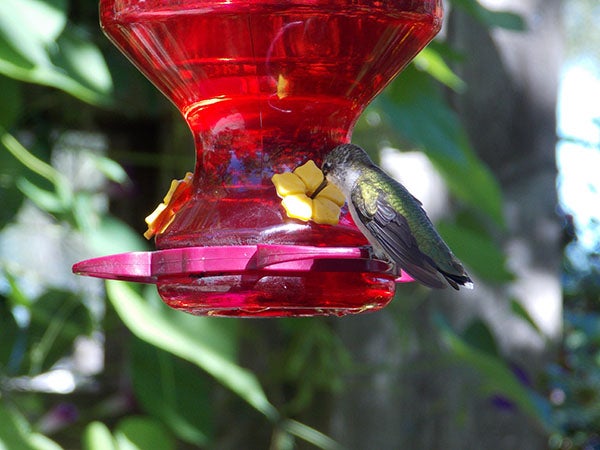The seasons are changing in gardens
Published 9:00 am Sunday, September 27, 2015

A hummingbird sipping nectar from the sugar water feeder in the September gardens. – Carol Hegel Lang/Albert Lea Tribune
Serendipity Gardens by Carol Hegel Lang
The gardens at my house are all about nature and they change with the seasons. This morning, as I took the dog outside very early, it was windy and a light mist was falling. As my eyes were drawn toward the sky I had one of those “aha” moments. Flying overhead were five great blue herons, probably heading towards Pickerel Lake after spending time on Albert Lea Lake. One of the delights of where our property is located is that I am on a flyway between these two lakes and I always see so many different kinds of birds.
Recently I found this quote on a bookmark that came in the mail from a nature magazine requesting me to join them, “The human spirit needs places where nature has not been rearranged by the hand of man.” — Author Unknown
My gardens are all about nature and I try to keep them as natural as possible while still being pleasing to the eyes. How I would love to invite all of you to bring a cup of coffee or a cold beverage to join me for some quiet time just sitting under the gazebo and enjoying all of what is visiting my gardens at that moment. You see, the things that visit my gardens also change with the seasons, as in the winter we have lots of sparrows, starlings, chickadee, nuthatches and cardinals that visit the feeders. These same birds seem to be here year-round, but you notice them more against the bright whiteness of the landscape. Who doesn’t love to see a cardinal all decked out in his bright red suit sitting on the evergreens and just calling your attention his way? While the cardinals are in my gardens during the summer months they seem to fade into the other colors of the gardens so you don’t notice them as easily. If you listen to their song, you will know they are there.
Squirrels and rabbits also are year-round visitors to the gardens, but there are so many other beautiful birds visiting that you really don’t notice them. When I hear or spot my first robin in March it tells me spring is just around the corner, and to be prepared for all of the migrating birds that will be coming through the gardens. When the first oriole arrives it’s like celebrating something special, and they are followed by the rosebreasted grosebeaks, scarlet tanager, indigo bunting and the colorful warblers that dart in and out of the trees looking for insects. The arrival of my wrens is a red letter day for me, as I just love listening to them as they serenade me while I am working in the gardens.
Roosevelt has done a wonderful job of protecting the gardens from not only the squirrels, but those pesky red squirrels and chipmunks that love to dig in my flower pots, sending the flowers to an early death as I find pieces of plants on the ground. He also seems to keep the feral cats under his control as to where they can be in the gardens so they only come out when he is in the house.
With the arrival of May the hummingbirds arrive, and it is time to really celebrate spring in the gardens as the tiny creatures zip around the gardens from feeder to feeder. Some of them will leave the area, while a few will spend the summer in my gardens drinking nectar, not only from the feeders, but the many fuchsia hanging baskets I have. Then in fall they arrive in great numbers as they fatten up for the long journey to Mexico, where they will spend the winter months. During this period I spend a great deal of time filling the feeders with sugar water, as not only the hummers love the nectar, but so do the bees and wasps.
As the gardens shout out with color in the late summer butterflies adorn the many zinnias and other plants. Some days there are monarchs, red admirals, yellow and white sulphur and both tiger and anise swallowtail butterflies flitting around. Many days the gardens have so much activity it just draws my attention to sit down and enjoy this marvelous spectacle before it comes to an end. Those days will soon be a memory of the past, and I will await their arrival again in the spring. So as the seasons change, so does the beauty of nature in the gardens.
“Look deep into nature, and you will understand everything better.” — Albert Einstein
Carol Hegel Lang is a green thumb residing in Albert Lea. Her column appears weekly. Email her at carolhegellang@gmail.com.



